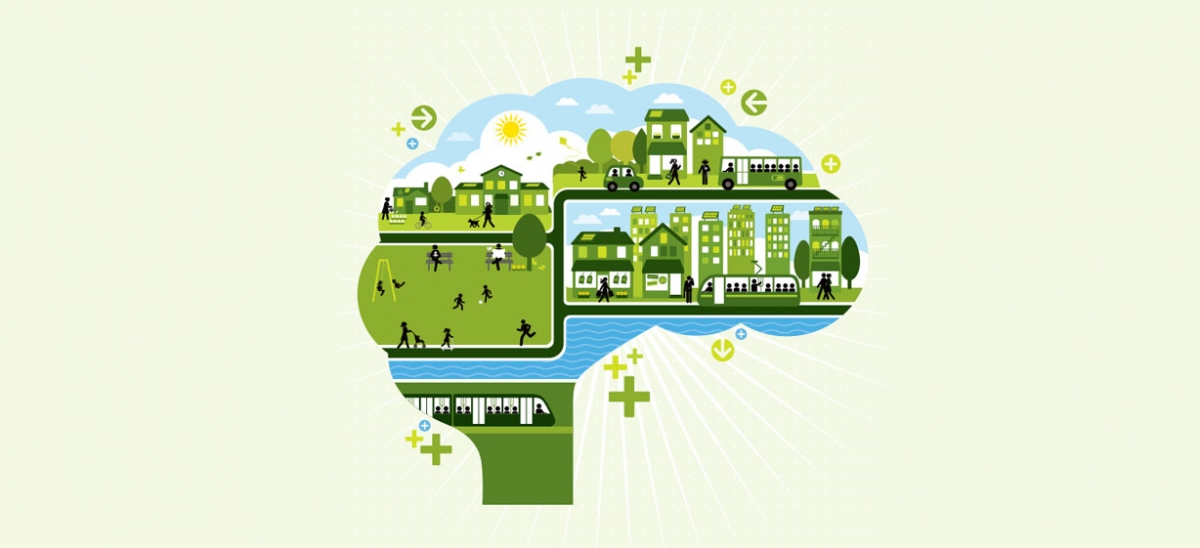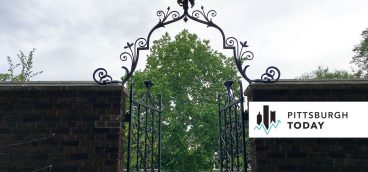
When drivers exit the turnpike in Cranberry, they see expansive strip malls, traffic signals and road signs leading to more highways. On its face, it’s a portrait of urban sprawl.
But a closer look reveals evidence of the steps the Butler County municipality has taken to make amends for the fragmented development of its past, including miles of sidewalk and tree-lined streets, a dense downtown core connected to housing developments and some of the most forward-thinking policies for smart growth found in southwestern Pennsylvania.
“It’s really about connectivity,” says Ron Henshaw, director of community development in Cranberry. “Our township was created out of pockets of development. Now, with development in-filling, requiring sidewalks and pushing those kinds of amenities, we’re connecting those things.”
The sprawl that Cranberry is working to address is a common American phenomenon that began to accelerate more than a half century ago with shifts in population away from large cities.
Sprawl is largely found in the suburbs of metropolitan areas. It is characterized by what is called “single-use development” that tends to separate shops, housing and industry from one another. And it results in communities that lack the population density, connectivity and the integrated live-work-play environment found in denser urban cities.
A report by nonprofit Smart Growth America finds the Pittsburgh metropolitan area to be near the middle of the pack in terms of sprawl among the 221 U.S. metropolitan areas it ranked from the most dense and connected to the most sprawling. Pittsburgh ranks as the 132nd most compact and connected city, more sprawling than cities such as Detroit and Baltimore, but more dense and accessible than Minneapolis and Charlotte.
“Sprawl is intentional or consequential fast-rolling development characterized by a lack of public transportation connections and low-density development at previously undeveloped spaces that, rather than strengthening formally developed neighborhoods, sap the life out of them,” says Court Gould, director of Sustainable Pittsburgh.
The cost of sprawl can be high. It adds to infrastructure and other public expenses, for example, and tends to erode social supports in disconnected suburban communities. It also drains cities of people, business and tax revenue. Studies also suggest, for example, that the increased vehicle miles traveled and car trips associated with sprawl significantly contribute to air pollution, such as ground-level ozone, which is a particular problem in southwestern Pennsylvania.
The rise of sprawl
The development of sprawl in Pittsburgh can be traced back to the city’s roots as an industrial city that developed along the rivers, rather than from a downtown business district. It spread quickly in the 1950s as development began to expand out from the City of Pittsburgh, and the trend continues today.
“The historical trend is sprawl, says David Miller, professor at the University of Pittsburgh Graduate School of Public and International Affairs. “There has been a movement out of the city. If you include the municipalities that share a common border with the city, they’re part of the urban core, and there’s been no significant growth in those communities. At the same time, Allegheny County’s overall population hasn’t decreased. It’s moved out to the fringes.”
The Smart Growth America report measured sprawl by looking at factors such as the density of residential and commercial development; the mix of homes, jobs and services in a community; how centrally located downtown districts and activity centers are; and the degree to which the street network is linked and pedestrian-friendly.
New York City, San Francisco and Atlantic City, N.J., top the ranking as the most densely developed and least sprawl-ridden metro areas in the country. Clarksville, Tenn., Atlanta, Ga. and Hickory, N.C., were ranked the most sprawling.
Sprawl has recently slowed in southwestern Pennsylvania. The most recent recession played a key role by reducing development and leading to government funds being directed more toward existing infrastructure. “Our fiscal reality became our growth policy,” Gould says.
The region’s rivers and rolling topography also help to keep the metropolitan area compact, as does the fact that Pittsburgh is an older city designed with public transportation and walking in mind. “If you have a midwestern city, you have no real barriers geographically to population spreading out,” says Bob Gradeck, of the University of Pittsburgh’s University Center for Social and Urban Research. “We have an older city, so we have this legacy of a dense urban core. And we don’t have a big beltway system like other cities, such as Atlanta.”
Not a benign factor
Sprawl is more than a simple living preference separating those who want to walk to work and the grocery store from those who desire a large yard on a quiet cul-de-sac.
“Sprawl is a problem from a regional resource allocation standpoint,” says Grant Ervin, sustainability manager for the City of Pittsburgh. “It’s not just the city of Pittsburgh but also all of the core communities: the cities of Washington, Butler and Greensburg. If we spread out, that necessitates an increase in public expenditures. By extending ourselves and creating new infrastructure that we have to support, it makes it more costly to support the infrastructure we already have. It’s really an issue of fiscal responsibility: how do we steward the resources we have and invest in the places where we already live?”
The spread of low-density living also has social consequences. Communities tend to become more isolated, which can contribute to higher rates of inequity, social division and a weakening of social supports. It is likely not a coincidence that the geography of poverty is changing; more poor Americans now live in suburbs than cities.
A recent Brookings Institute study of poverty trends found that poverty has become a significant issue in suburban America. Researchers reported poverty increased in 388 of the 435 U.S. congressional districts from 2000 to 2011, based on Census Bureau data. And nearly 80 percent of the nation’s congressional districts contain suburbs.
Locally, poverty rose by at least 10 percent in three of the five congressional districts in the Pittsburgh Metropolitan Statistical Area and remained relatively flat in the others. All three districts that experienced higher poverty contain suburban communities where sprawl tends to be found. Poverty increased 12.9 percent in the 14th Pennsylvania Congressional District, the highest increase in the region. The district includes the City of Pittsburgh and dozens of suburban Allegheny County municipalities. Two largely suburban districts, the 12th and 18th, also saw significant increases in poverty rates.
“Sprawl has been shown to break down both suburban and urban communities of support rather than foster them,” Gould says. “So it breeds a twin hardship in this sense.”
Policy matters
Evidence suggests that the recent slowing of sprawl across Pennsylvania is largely the result of economic hardships imposed by the last recession, rather than a decided turn toward smart-growth policies. The state’s most recent Land Use and Growth Management report shows, for example, that developed land increased 131 percent statewide between 1992 and 2005, and by 81 percent in southwestern Pennsylvania, before slowing to a trickle in 2008.
Smart-growth policies have not yet been widely adopted across the region despite increasing awareness of its economic, environmental and social impacts. One reason is that policies that tend to curb sprawl are often seen as stifling growth, particularly in older communities that lack a long-term development strategy to accommodate for shifts in population and commerce.
“A large portion of the region operates from scarcity rather than abundance,” Ervin says. “We’re not all thinking on the same page. There’s still a lot of thinking out there with regards to development at any cost. A large portion of that is because of our governance structure. They haven’t seen how to grow and develop in a way that’s more responsible. When you see communities employ higher standards for land use and infrastructure investment, they get better product, and they attract a market that is sustainable.”
Effective policies for reducing sprawl require local governments to think regionally when it comes to development, and that has proven to be a challenge for a number of reasons. Government in Greater Pittsburgh is highly fragmented, posing a steep challenge to regional cooperation. The seven-county Pittsburgh metropolitan statistical area has some 900 municipalities, school districts and other government bodies, according to U.S. Census data. Only the St. Louis area has more among the 15 benchmark regions tracked by Pittsburgh Today.
And until the state’s Municipalities Planning Code was amended in 2000, it wasn’t possible for a municipality to implement a multi-municipal plan—limiting intergovernmental cooperation and regional land-use planning efforts.
Under the previous code, if a municipality regulated land use for zoning, it had to allow for every use, something that is impractical for a small municipality. Now those uses can be shared across municipalities by creating a multi-municipal planning area. “That’s one of the changes that made multi-municipal planning possible, and it has the potential to diminish sprawl,” says Susan Hockenberry, executive director of Local Government Academy.
One high-profile example of multi-municipal cooperation in the region is the Waterfront retail and entertainment complex, which led the boroughs of Homestead, West Homestead and Munhall to create a multi-municipal tax base-sharing plan.
But the outlook for increased multi-municipal planned projects is mixed. State budget cuts, for example, have limited funding to help support such cooperation among municipalities. “Our grant program often served as a local match for state funding,” Hockenberry says. “It has been really thinned; there is a lot more interest than there are resources to provide assistance.”
Among the issues smart growth policies address is the impact that unbridled development can have on the tax burden of residents. A sprawling suburban development can impose long-term costs for everything from police and fire protection to road maintenance and public employee pension obligations that are greater than revenues municipalities receive from developers and developments.
Cranberry began adopting smart- growth policies after it overhauled its zoning ordinance in 1995, more than a decade after it began to grow from a sleepy rural community to a sprawling suburb with the expansion of highway arteries to Pittsburgh and the lure of lower taxes outside of the city and Allegheny County.
The township was one of the first municipalities in Pennsylvania to charge developers a transportation impact fee as a way of relieving some of the economic burden new developments tend to bring with them. The one-time fee is based on a development’s use of the local road system, and the money is put toward transportation projects in the community.
Cranberry supports development of recreation space in a similar manner. Developers can either build recreational amenities or pay a one-time fee to the township, which the municipality spends on parks and recreation projects.
The township also implemented progressive zoning codes for mixed land use, which allow for greater density, and Cranberry now focuses on building pedestrian ways and bikeways to enhance the connections between neighborhoods and the business district as the municipality grows. These policies “created huge opportunities for redevelopment of old spaces and the ability to make them integrated,” says development director Henshaw.
Long-term planning strategies in the City of Pittsburgh in the past five years have turned to emphasizing the quality of development in the city, rather than the rate. For more than a half century, the region’s urban core—the city and Allegheny County—saw large numbers of its residents migrate to the suburbs. The exodus, however, has slowed significantly in recent years with the city witnessing a surge in Downtown residency and a rise in the popularity of neighborhoods such as Lawrenceville.
“We recognize that a lot of the core assets we have are in our neighborhoods,” Ervin says. “With our existing infrastructure, the question that we ask ourselves is how do we support those neighborhoods through quality transit service and improving bike and pedestrian safety so we have mobility options for our residents and create a higher standard for development? Going forward 20 years, development quality is a huge opportunity.”




